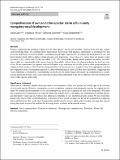Comprehension of own and other species’ alarm calls in sooty mangabey vocal development
Abstract
Primates understand the meaning of their own and other species’ alarm calls, but little is known about how they acquire such knowledge. Here, we combined direct behavioural observations with playback experiments to investigate two key processes underlying vocal development: comprehension and usage. Especifically, we studied the development of con- and heterospecific alarm call recognition in free-ranging sooty mangabeys, Cercocebus atys, across three age groups: young juveniles (1–2y), old juveniles (3–4y) and adults (> 5y). We observed that, during natural predator encounters, juveniles alarm called to a significantly wider range of species than adults, with evidence of refinement during the first four years of life. In the experiments, we exposed subjects to leopard, eagle and snake alarm calls given by other group members or sympatric Diana monkeys. We found that young juveniles’ locomotor and vocal responses were least appropriate and that they engaged in more social referencing (look at adults when hearing an alarm call) than older individuals, suggesting that vocal competence is obtained via social learning. In conclusion, our results suggest that alarm call comprehension is socially learned during the juvenile stage, with comprehension preceding appropriate usage but no difference between learning their own or other species’ alarm calls. Significance statement: Under natural conditions, animals do not just interact with members of their own species, but usually operate in a network of associated species. However, ontogenetic research on primate communication frequently ignores this significant element. We studied the development of con- and heterospecific alarm call recognition in wild sooty mangabeys. We found that communicative competence was acquired during the juvenile stages, with alarm call comprehension learning preceding appropriate vocal usage and with no clear difference in learning of con- and heterospecific signals. We also found that, during early stages of life, social referencing, a proactive form of social learning, was key in the acquisition of competent alarm call behaviour. Our results show that primates equally learn to interpret alarm calls from their own and other species during their early stages of life and that this learning process is refined as the animals mature.
Citation
León , J , Thiriau , C , Crockford , C & Zuberbühler , K 2023 , ' Comprehension of own and other species’ alarm calls in sooty mangabey vocal development ' , Behavioral Ecology and Sociobiology , vol. 77 , no. 5 , 56 . https://doi.org/10.1007/s00265-023-03318-6
Publication
Behavioral Ecology and Sociobiology
Status
Peer reviewed
ISSN
0340-5443Type
Journal article
Description
Funding: Open access funding provided by University of Neuchâtel This work was funded by the Swiss National Science Foundation (Grant numbers 31003A_166458; 310030_185324; 51NF40_180888) (KZ).Collections
Items in the St Andrews Research Repository are protected by copyright, with all rights reserved, unless otherwise indicated.

